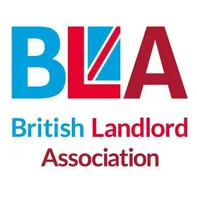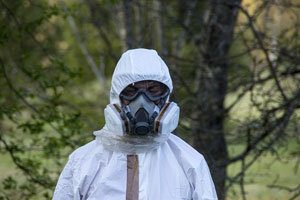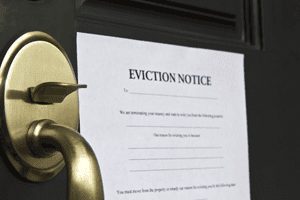What is asbestos?
Asbestos is a potentially harmful mineral fibre that was used extensively in buildings between the 1950s and 1980s.
Use of asbestos was banned in the UK in 1999 but you can still find it in many properties. Landlords should assume that asbestos is present in all pre-2000 buildings. If it’s in good condition and not damaged or disturbed then it shouldn’t present a risk.
But if the fibres become loose, they might be inhaled, which could result in diseases of the lungs and chest lining. That might take between 15 and 60 years to develop.
A landlord’s duty towards asbestos
Under Regulation 4 of the Control of Asbestos Regulations 2006, landlords have certain duties towards their tenants to minimise the risks of exposure to asbestos. The landlord has responsibility for the maintenance or repair of non-domestic premises through a tenancy agreement or contract. The extent of the landlord’s duty will depend on the nature of the agreement.
This is relevant to rental properties because, as well as industrial, commercial and public buildings, ‘non-domestic premises’ also include ‘common’ areas of certain domestic premises, such as purpose-built flats or houses converted into flats. Common areas might include:
Foyers
• Corridors
• Lifts and lift shafts
• Staircases
• Boiler and plant rooms
• Storerooms
• Roof spaces
Gardens
• Yards
• Outbuildings
• Garages
• Sheds
• Bike shelters
The flat itself is not included and ‘common’ areas would not include rooms within a private residence that are shared by more than one household. For example, bathrooms and kitchens in shared houses, and communal dining rooms and lounges.
Minor asbestos damage
- Repair/encapsulate the material
2. Regularly monitor the condition of the material
3. Label the material, where practical
4. Make sure contractors and other workers who are likely to disturb material are informed of the actual or potential presence of asbestos Asbestos in poor condition.
Remove the asbestos Asbestos disturbed
- Remove any asbestos likely to be disturbed Always exercise caution when it comes to asbestos. If you suspect or are aware of asbestos in your premises, contact a specialist to ensure that neither you nor your tenants are at risk.
Guidance Notes from HSE
Advisory note on the refurbishment of housing stock likely to contain asbestos Introduction This Advisory Note on asbestos is primarily concerned with major refurbishment programs such as those being undertaken to meet the Decent Homes standard or similar such capital projects where local authorities, housing associations and social housing management companies are the client under the Construction (Design and Management) Regulations 2007 (CDM).
However, the principles contained within it are equally applicable to routine refurbishment/ maintenance work across all housing sectors Asbestos Containing Materials (ACMs) may be present in many locations within domestic premises.
Some of the commonest include airing cupboards, bath or similar panels and heating systems. Under CDM, clients have to comply with certain duties in relation to asbestos. These duties are not transferable and cannot be delegated to a managing agent or principal contractor.
The specific ‘duty to manage’ requirement under the Control of Asbestos Regulations 2006 does not apply to any domestic property. However the general duties under the Health and Safety at Work etc. Act 1974 requires employers to ensure the health and safety of employees and others so far as reasonably practicable.
The Management of Health and Safety at Work Regulations 1999 also require employers to assess the health and safety risks to third parties, such as workers carrying out work in the premises and tenants, who may be affected by activities connected with their business and to make appropriate arrangements to protect them from this.
This Advisory Note sets out reasonably practicable steps that clients should take when their properties are refurbished or maintained.
Information on Asbestos Clients should provide sufficient information about the location and type of ACMs in order to allow effective management of the risks during any refurbishment or maintenance work. Asbestos was widely incorporated into buildings until the nineteen eighties after which time its use declined.
However, the use of all forms of asbestos in domestic buildings was not prohibited until 1999. Consequently, buildings constructed after 1999 can be presumed to be asbestos-free. Materials in pre-2000 buildings cannot be considered to be asbestos-free unless there is strong evidence to conclude that they are highly unlikely to contain asbestos.
You must assume that asbestos is present in areas to be refurbished unless you have the appropriate information to indicate that it is not. The steps below should be taken to determine whether asbestos is present and to obtain information about the position and condition of ACMs.
A “refurbishment/ demolition” survey is necessary before carrying out any work that may disturb the fabric of a building. The purpose of this survey is to locate ACMs so that they can be removed before the refurbishment work starts.
This type of survey is likely to be intrusive and destructive. Intrusive inspection techniques are employed where appropriate to lift carpets and tiles and break through walls, ceilings, cladding and partitions.
These destructive techniques mean that surveys need to be conducted in unoccupied areas to minimise any risks to tenants.
For minor refurbishment, this would only apply to the room involved or even part of the room where the work is small and the room large. In these situations, there should be effective isolation of the survey area (e.g. full floor to ceiling partition), and furniture and furnishings should be removed as far as possible or protected using sheeting.
The “surveyed” area must be shown to be fit for reoccupation before refurbishment work continues or tenants are allowed access. Given the above surveys should be programmed to take maximum advantage of any periods when properties are untenanted or ‘void’.
Survey Strategy It is unlikely that a survey of every property is going to be reasonably practicable where a large number of tenanted dwellings are involved in a refurbishment project. A carefully planned sampling program of a representative proportion of each dwelling ‘type’ will thus be needed in order to get an accurate picture of ACM presence.
Specific sampling ratios cannot be specified, as these will depend on the variability of the housing stock. The sampling strategy should be informed by the advice of a competent surveyor and take account of:
- Original construction information
• Building material specifications
• Subsequent refurbishment or building works
• Previous asbestos surveys or removals
• Information generated during the survey process itself that may necessitate a revision of the original planning assumptions
The value and usefulness of a survey can be seriously undermined where either the client or surveyor imposes restrictions on the scope or technique/method used. It is crucial that, so far as is reasonably practicable, information is provided on the location of all ACMs.
Any restrictions are Likely to affect this and may mean that the work program becomes more complex, delayed and expensive.
Provision of Information
The information provided by a suitable survey is of little value if it is not provided appropriately and in good time for those that need to act upon it. Where asbestos is identified, it may have to be removed and arrangements will have to be made.
Both the * A ‘refurbishment/ demolition’ survey is the term used in ’Asbestos: The survey guide’ (HSG264), published in 2010. It replaces the ‘Type 3’ survey. The form of the survey records and final report format should therefore be agreed before starting a survey.
When agreeing on this format consideration should be given to how it is going to be supplied, shared and updated by those that need it. Not only is this important in the current scope of work, but it can also save time and money on future projects.
Competent Contractors Even when a suitable survey has been undertaken, it is still foreseeable that unknown ACMs may be encountered when construction work begins. It is, therefore, important that contractors undertaking the work know what to look for and the precautions that they should adopt.
Clients have a duty to take reasonable steps to ensure that anyone they appoint is competent. Knowledge of asbestos risks and working precautions form an element of this competency. Steps should be taken to check that potential contractors have had the relevant asbestos awareness training to an equivalent standard to that required for non– domestic premises as outlined in the Approved Code of Practice to the Control of Asbestos Regulations 2006.
Similarly, those selected to carry out the survey work should also be able to demonstrate the requisite arrangements, skills and experience through such means as UKAS accreditation or personal certification.
British Landlords Association – Free national landlords Association for UK landlords & Letting Agents, why not join us today for Free!
Date; 01/01/19
Source; Tracy Hemming
Latest 2020 Assured Shorthold Tenancy
Free Landlord Helpline for UK Landlords 2020
7 top tips how to evict a tenant quickly under Coronavirus
Is it worth being a landlord in 2020, is it still profitable?





